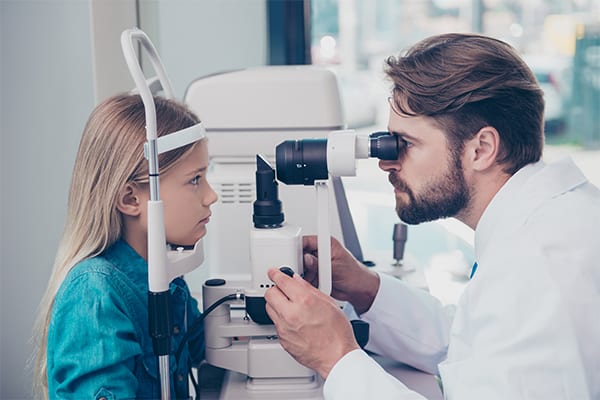

Diagnosing Children With Their Vision Problems Part 2
This article is a continuation and will discuss some most common eye diseases we come across while examining a child
The eye care practitioners should be well versed with the conditions to give the best support, advise and refer the patients when necessary. Below are some eye diseases that can affect the child’s ability to develop a vision and need early detection.
Epiphora
The child with watering or sticky eye
When noted during infancy with excess watering and stickiness, parents are advised for tear sac massage and maintain lid hygiene. This usually improves by 6-12 months of age in 95% of cases. But if tearing persists, surgical probing of the drainage system may be required and that is the time early referral to an Ophthalmologist is necessary.
Conjunctivitis
Conjunctivitis in children is usually bacterial or allergic. In bacterial infection, complaints are red eyes with discharge, photophobia and are treated with antibiotics. To start with, topical antibiotics can be prescribed but depending on the severity of redness, referral to an Ophthalmologist may be required. In allergic conjunctivitis, patients complain of rubbing of eyes, itching and discomfort which may be seasonal or perennial. They should be referred to an Ophthalmologist based on the severity of papillae for further treatment.
If the child’s condition worsens and they are unable to open their eyes, this indicates keratoconjunctivitis where they should be seen within 48 hours by an ophthalmologist as it may have permanent effects on their vision.
Congenital Cataract
A child with delayed visual development
A cataract is often missed to diagnose after birth and later in infancy may present with delayed visual behaviour or a squint. If there is a dull red reflex or white reflex found during the examination, they should be referred to an ophthalmologist immediately within a week to exclude from retinoblastoma. Cataract surgery is often performed as early as possible to avoid amblyopia.
Congenital Glaucoma
Glaucoma in children includes signs and symptoms like cloudy cornea, tearing, frequent blinking, light sensitivity, and redness of the eye. They usually have high intraocular pressure and must be immediately referred to an ophthalmologist for a further opinion as it is a sight-threatening disease.
Cortical Visual Impairment
Cortical visual impairment (CVI) is vision loss due to any abnormality of the visual center in the brain. The eyes are normal, but the visual interpretation center in the brain does not function properly and prevents normal vision.
Congenital Ptosis
Patients complain of droopy eyelids which can be congenital or acquired. It is caused by weakness of the levator muscle of the eyelid. A droopy eyelid can block light passing to the retina causing blurred vision which may further lead to amblyopia and, if left untreated, can result in permanent loss of vision. If the ptosis is significant, surgical correction is necessary and so should be referred to an Ophthalmologist.
Retinopathy of Prematurity
Retinopathy of prematurity (ROP) is an eye disease that occurs in some premature infants. Premature infants at risk of ROP are identified in the hospital itself and enrolled in a routine screening protocol. ROP is progressive, starting with mild changes and sometimes progressing to severe, sight-threatening changes and may need laser treatment and should be managed by an ophthalmologist. Complications of ROP can include strabismus, myopia, cataract, and, in severe cases, retinal detachment.
Orbital Cellulitis
A child with a lump in the eye
When a child is brought with acute periocular redness and swelling, it is assumed to be a case of orbital cellulitis. It is a very sight-threatening disorder and affected children should be referred to an ophthalmologist and admitted to the hospital immediately for intravenous antibiotics.
Rhabdomyosarcoma
When a child presents with a non-inflammatory mass that progresses rapidly in weeks is assumed to have rhabdomyosarcoma, the most common orbital tumour in children. Any child with such rapid progression of proptosis should be seen by an ophthalmologist immediately within a week.
Chalazion
If a child presents a painless lump on the eyelid, it is suggestive of a chalazion caused by the blockage of meibomian glands. The parent is advised to do hot fomentation and massage it to try to express it through the gland orifice. If the chalazion is recurring or persists for a long time should be referred to an ophthalmologist.
Stye
A style looks like a red, painful lump near the edge of the eyelid and is caused by an infected eyelash follicle. It can be treated with just hot fomentation and sometimes antibiotic eye drops.
Nystagmus
Other presentations
Nystagmus is an involuntary, rhythmic oscillation of the eyes. The eye movements can be side-to-side, up and down or rotary. Nystagmus may be congenital or acquired. It may result from abnormal binocular fixation early in life. It also may accompany a number of eye disorders and neurological disorders and to rule out should be referred to an ophthalmologist.
Developmental Abnormalities
During the development of the fetus, abnormalities in the visual system can occur. Some developmental abnormalities include coloboma, microphthalmia, and optic nerve hypoplasia. These abnormalities often result in vision loss and need immediate intervention.
Genetic Eye Disease
Many eye diseases associated with genetic disorders are often inherited with a previous family history of the same. In such cases of known inherited eye disease, early evaluation is important. Diseases like rod-cone dystrophy or retinitis pigmentosa or Stargardt's and others need ERG to be done and immediately refer to an ophthalmologist.
Conclusion: An early diagnosis and timely referral with treatment by following this simple approach are critical in preserving the child’s vision and eye health.





